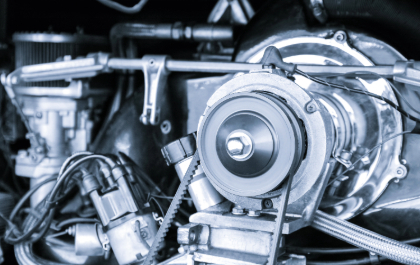INDEPENDENT NATIONAL DEALER
Nationwide-USA
San Diego, CA
(800) 653-0323
OUR BLOG
If you aren’t familiar with mechanics and how vehicles work, learning all the terms associated with them can be a hassle. To help you out, Synthetic Oil Inc. in San Diego, CA has this engine glossary that you should know.

Understanding engine terminology can help car owners diagnose issues, communicate effectively with mechanics, and maintain their vehicles more efficiently. Whether you're a beginner or an automotive enthusiast, go through this engine glossary to be in the know.
Call Synthetic Oil Inc. in San Diego, CA, at (800) 653-0323 or visit AMSOIL's online shop to protect and lubricate your engine correctly.
Basic Engine Glossary
Air-Fuel Ratio (AFR) – The proportion of air to fuel in the combustion chamber.
Alternator – A component that generates electricity to charge the battery, which in turn, powers the electrical systems.
Aftermarket Parts – Engine parts not made by the original manufacturer but designed to replace or enhance OEM (original equipment manufacturer) components.
Boost – The increased air pressure supplied to the engine by a turbocharger or supercharger, which improves power and efficiency.
Bore – The diameter of a cylinder in the engine block.
Camshaft – A rotating shaft with lobes that control the opening and closing of the engine’s intake and exhaust valves.
Catalytic Converter – A device that controls emissions and converts harmful gases into less toxic emissions.
Compression Ratio – The ratio of the cylinder’s maximum to minimum volume.
Connecting Rods – Components that connect the pistons to the crankshaft, transferring motion and power within the engine.
Crankshaft – A rotating shaft that converts the up-and-down movement of the pistons into rotational motion to power the vehicle.
Detonation (Knock) – The uncontrolled explosion of the air-fuel mixture in the combustion chamber. This can cause damage to the engine and is often caused by low-quality fuel or incorrect timing.
Displacement – The total volume swept by all cylinders in an engine, typically measured in liters or cubic inches.
ECU (Engine Control Unit) – The computer that manages fuel injection, ignition timing, and emissions to optimize engine performance.
Exhaust Manifold – It’s a component that works toward collecting exhaust gases from the cylinders and directing them into the exhaust system.
Engine Block – The main structure of the engine, housing the cylinders, pistons, and various internal components.
Engine Mounts – Brackets that secure the engine to the vehicle’s frame, reducing vibrations and movement.
Fuel Injector – The fuel injector is basically a nozzle that helps the combustion process by spraying fuel into the engine.
Fuel Pump – A component that delivers fuel from the tank to the engine at the correct pressure.
Flywheel – A rotating disc that helps maintain engine stability and transfers power to the transmission in manual vehicles.
Gasket – The gasket is a sealing material used between engine components and that’s there to prevent leaks of oil, coolant, or gases.
Glow Plug – A heating element in diesel engines that helps ignite the fuel-air mixture in cold conditions.
Horsepower (HP) – A measurement of an engine’s power output.
Feed your engine with AMSOIL's Signature Series 0W-20 Synthetic Motor Oil, the best synthetic oil in San Diego, CA.
Hydraulic Lifters – Components that help maintain proper valve clearance, reducing noise and wear in the valvetrain.
Idle Speed – The speed of the engine when the vehicle isn’t moving.
Intake Manifold – A component that distributes air to the cylinders.
Mass Airflow Sensor (MAF Sensor) – A sensor that helps adjust fuel delivery by measuring the amount of air that’s going into the engine.
Main Bearings – Bearings that support the crankshaft and allow it to rotate smoothly.
Motor Oil – An essential lubricant that reduces friction, cools, and protects engine components.
Octane Rating – A measure of a fuel’s resistance to knocking or detonation.
Oil Filter – A component that removes contaminants from engine oil.
Oil Pan – The reservoir that holds engine oil at the bottom of the engine.
Piston – A cylindrical component that moves up and down within the cylinder, compressing air and fuel before combustion.
Piston Rings – Seals around the piston that prevent oil and combustion gases from leaking.
Radiator – A heat exchanger that dissipates excess heat to help the engine cool off.
Rod Bearings – Bearings that support the connecting rods.
RPM (Revolutions Per Minute) – A measurement of how fast the engine’s crankshaft is spinning.
Spark Plug – In gasoline engines, the spark plug ignites the air-fuel mixture.
Supercharger – A device that forces more air into the engine, increasing power output.
Throttle Body – It controls the amount of air entering the engine based on driver input.
Timing Belt/Chain – A belt or chain that synchronizes the rotation of the crankshaft and camshaft.
Torque – A measure of rotational force.
Turbocharger – A device that uses exhaust gases to force more air into the engine, increasing efficiency and power.
Vacuum Leak – A leak in the engine’s air intake system that can cause rough idling, loss of power, and poor fuel efficiency.
Water Pump – A component that circulates coolant through the engine.
Wastegate – A valve that regulates boost pressure in turbocharged engines to prevent excessive pressure buildup.